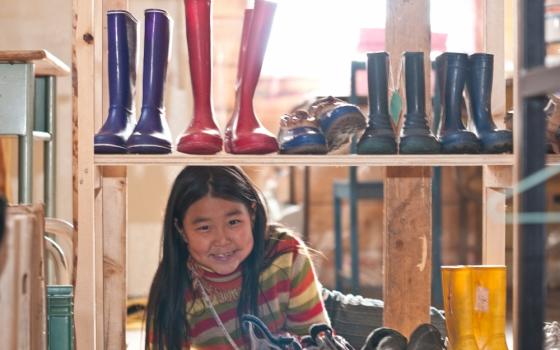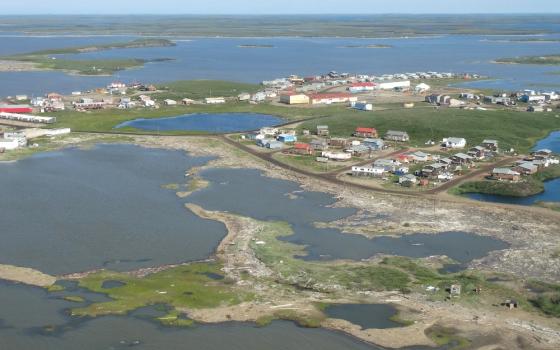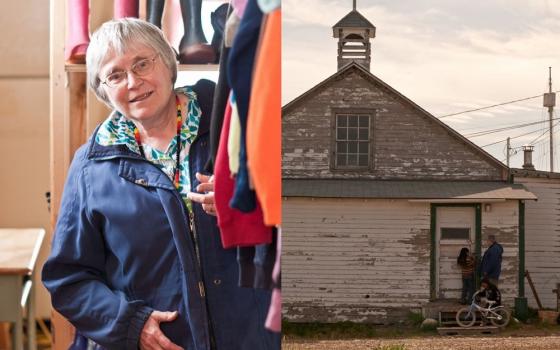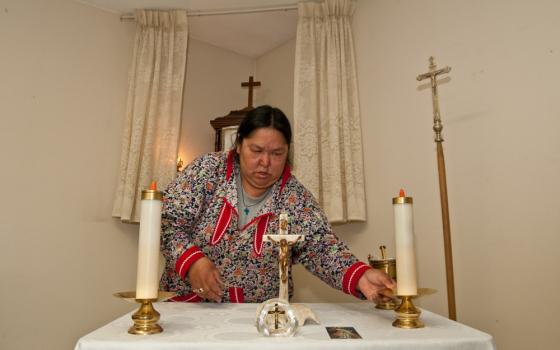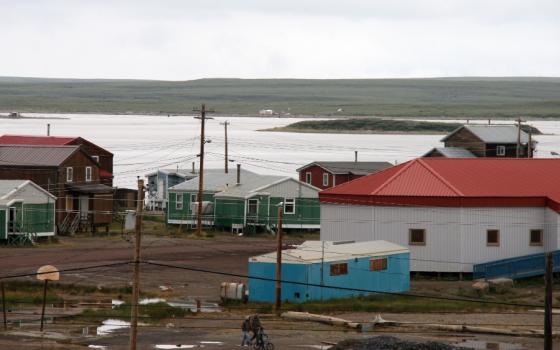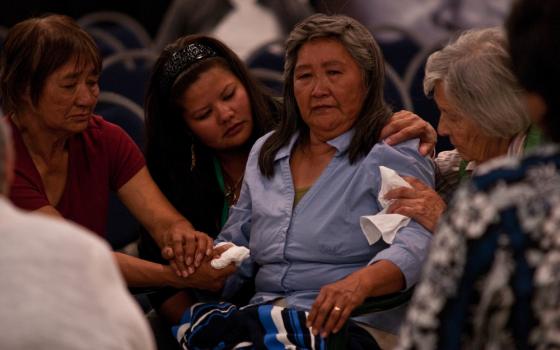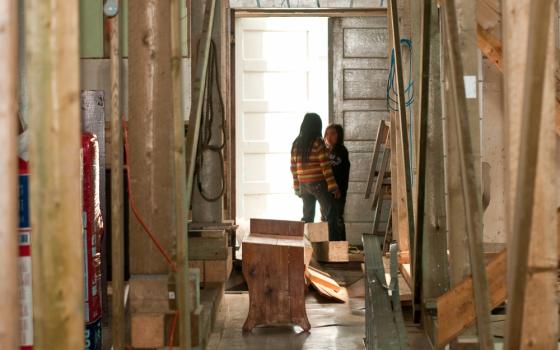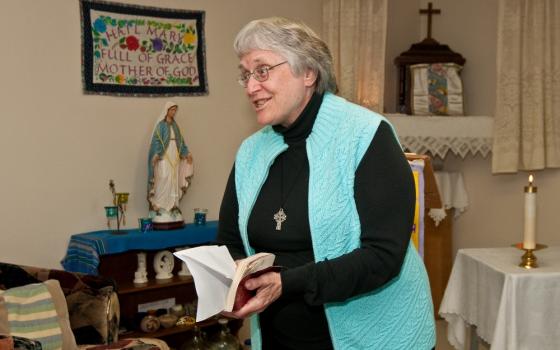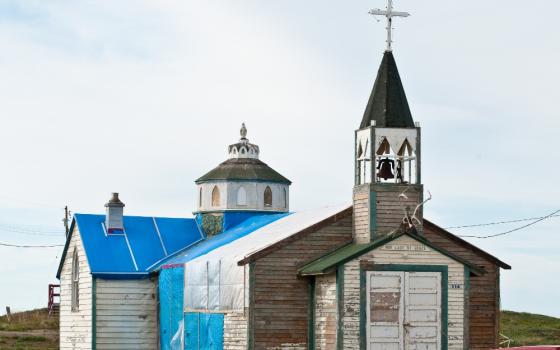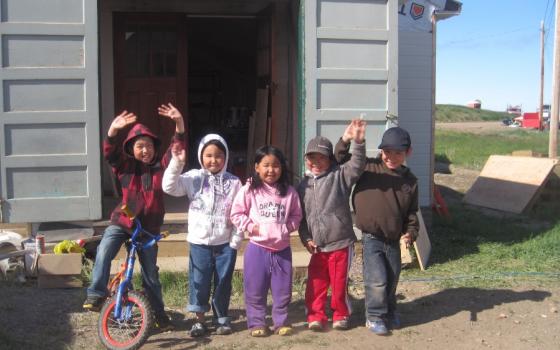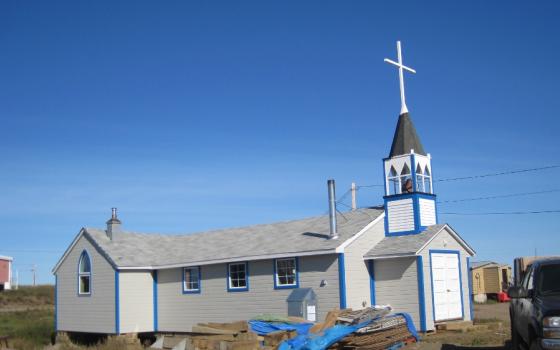For most of the year, Tuktoyaktuk is accessible only by air. In the winter, however, it’s a different story. Then – when the temperature has dropped to 40 degrees below zero – then you can reach the tiny hamlet perched above the Arctic Circle via the Winter Road, that is, on an icy pathway on top of the frozen Arctic Ocean.
And for that reason, Tuk – as it’s often called – has very few visitors.
But Fay Trombley, a Sister of Charity of the Immaculate Conception and a native of British Columbia, has made Tuk her home for the last 10 years. After her retirement, the 74-year-old former seminary educator says she settled in the hamlet not for the peace and solitude one could find in a place with only 950 people, but rather to fulfill a girlhood dream of serving as a missionary at the top of the world.
It seemed like the perfect post-retirement plan.
“I thought, ‘I have both the desire to go to the people of the Arctic and also the capacity to bring some kind of articulation of our faith because of my theology background,’” she said from her home, which doubles as a food bank, community center and, occasionally, a church for the hamlet’s 20 to 40 Catholics.
During the summer, when many Inuvialuit, the indigenous people making up Tuk’s population, are out fishing and hunting (“on the land,” as they say), church has been held in Trombley’s home. And church was held there in the winter when it’s too cold and thus too expensive to heat the official church, Our Lady of Grace.
For the last five years, however, church has been in Trombley’s home every Sunday because Our Lady of Grace has been under much needed repair. Construction was only finished this summer, and the occasion was marked by the presence of a priest – something that only happens about five times a year. Normally there's a lay service, but the faithful are still able to have Communion; the priest, when he flies in, consecrates enough Eucharistic hosts for both Trombley personally and the weekly services.
“It’s not Mass,” Trombley said, “but we have a wonderful little service, which is very appropriate to the faith of the people.”
The faith of the Inuvialuit people is an important issue for Trombley – it’s why she came to Tuk, after all – but it’s also a complicated issue. Today, Trombley is one of the few non-indigenous persons living in Tuk, but not long ago there was no shortage of European Catholic and Anglican missionaries pushing hard to convert the Inuvialuit to their Western faiths and traditions.
Beginning in the late 19th century, the primary component of these evangelization efforts were the Indian Residential Schools, government-funded but church-run schools in which some 150,000 aboriginal children across Canada were taken from their families and made to shed their native cultures. Students would be punished for speaking their native language, and many also faced physical, mental and sexual abuse. Last year, the Canadian Broadcasting Corporation reported that some schools even performed medical experiments on students, with government approval.
Trombley says the children from Tuk faced abuse from two or three supervisors, all lay people who were eventually charged. Most of the abuse was psychological and physical (one young girl had her fingers broken when she was hit with a strap), but some of it was sexual. Trombley says the Inuvialuit usually don’t talk about that. Three boys ran away from their school in Inuvik and attempted to walk the 90 miles back to Tuk. Only one made it, and no one has ever heard what happened to the other two.
The last Canadian residential school closed in 1996, and by that point, the worst of the abuses had been eradicated and local education options were finally available. Still, Trombley estimates that between 80 and 90 percent of Tuk’s population today was affected by the residential schools, either directly or indirectly. When something occurs over multiple generations, she points out, the ripple effect tends to last for a while.
“Whole generations – probably a couple generations – never watched parents raise kids,” she said. “I would say there’s a large number in Tuk that have no idea how to parent. They only know either how to spoil or just let their kids do what they want, because generations ahead of them couldn’t do what they wanted. So they’re in the phase of doing the opposite.”
Furthermore, she says, in Tuk, there’s also still a lot of residual anger toward the Anglican and Catholic churches, the Canadian government and white people as a whole for the way the Inuvialuit were dishonored by the residential schools.
“I don’t know if ‘hate’ is too strong a word, but they don’t have any love for the people who scraped them off the land, put them in settlements and took their kids away – sometimes 2,000 or 3,000 miles from home – in a residential school,” she said. “They lost everything. They lost their parents, they lost their brothers and sisters because boys were separated from girls, they lost their language and they lost their traditional skills.”
One of the great catastrophes of the residential schools, Trombley says, was that the children who went through them were divorced from their native cultures and yet were never adequately prepared for assimilation into broader Canadian culture, which had been the whole point. When the children left the schools, she says, they didn’t fit in anywhere, and it damaged their confidence and self-image.
“They would go home in the summer and not know how to pluck geese. They didn’t know how to trap muskrat, they didn’t know how to prepare whale up for food,” she said. “So they go home and they’re ignorant, and then in the school year, they go to school and they’re considered ignorant because they are ‘just from the land.’”
Some reconciliation after more than a century of changes
In September 2005, on behalf of all the Inuvialuit who had attended residential schools, the Inuvialuit Regional Corporation filed a lawsuit against the attorney general of Canada. An agreement reached two months later awarded the group more than $2 billion to be used for compensation and programs related to healing and preserving survivors’ stories. The settlement also made Inuvialuit who had experienced abuses leading to “serious psychological effects” eligible for an additional $5,000 to $275,000.
“For the first time, Canada has acknowledge the profoundly negative impact residential schools had on Aboriginal language, culture and family life across Canada,” said Paul Kaludjak, then-president of the Inuvialuit Regional Corporation, in a statement following the settlement. “By making compensation, recognition and healing available to former students, this settlement will help us begin to heal and move on with our lives. It brings closure to one of Canada’s great injustices.”
Additionally, in 2008, borrowing from South Africa’s restorative justice process, Canada began a Truth and Reconciliation Commission with sessions for Arctic communities from January 2011 to April 2012. In the sessions, survivors of the residential schools are invited to share their experience. The idea is that sharing these stories invites all Canadians to acknowledge the past and take responsibility for restoration.
Lori Ransom, the commission’s church relations senior advisor, says the process has done a great deal to move Canadians forward in the healing process.
“It’s always challenging to be asked to self-evaluate in terms of how we’re doing,” she said, “but survivors have told us they’ve valued the opportunity to come and tell their stories. Thousands of Canadians have come out and, as we continue our work, more and more different organizations have come forward to say, ‘Hey, we want to be a part of this.’ So that’s very affirming.”
Even still, the healing is far from finished. No Inuvialuit or Tuk government officials were willing to be interviewed for this article. But Trombley (who, incidentally, attended the Arctic Truth and Reconciliation Commission sessions, just to listen) says Tuk, still reeling from the past century and a half of trauma, is now trapped in a culture of poverty, alcoholism and depression.
People in Tuk got money from the Inuvialuit Regional Corporation’s settlement with the Canadian government, some of them upwards of $13,000. Trombley says a few used the money to buy a boat or a car and, for the most part, people had spent it all in just a matter of months.
There are few skilled workers in Tuk, she says. When someone needs plumbing work or furnace repairs, labor has to be flown in, which is expensive. And to get a decent 11th or 12th grade education, Inuvialuit have to go to Yellowknife or Edmonton – 700 and 1,000 miles south of Tuk, respectively.
But it’s not just the residential schools that created this. The important thing to remember, says David Morrison, director of research at the Canadian Museum of History’s Canada Hall and co-author of one of the only comprehensive Inuvialuit histories, is that the residential schools are just part of the Inuvialuit’s painful story.
“The residential schools are like the nail in the coffin,” he said from his Ottawa office. “I’m not trying to say they were a good thing or were not disastrous, but there was so much else going on, that it’s only one factor in all of the things. The Inuvialuit probably suffered more profound cultural change between 1870 and 1930 than any group you can possibly imagine of the face of earth – just enormous things happened.”
For starters, when American whalers first came to the Arctic in 1890, they brought with them European diseases and wiped out 90 percent of the Inuvialuit population in just two generations. Towns were abandoned and Alaskan Inuit moved in. Before long, Morrison says, the entire Inuvialuit way of life had collapsed. In fact, he says, the old way of life so many Inuvialuit children lost in the residential schools, was actually a new way of life for their ancestors – a new way of life brought by the whalers, the Alaskan immigrants and, eventually, the fur trappers who introduced the Inuvialuit to modern marvels like repeating rifles, cotton clothing and a cash economy.
Anyone would be shaken, Morrison says, by such rapid change in every aspect of their cultural life; even the rampant alcoholism in Tuk – which Morrison says underlies all of the hamlet’s current social problems – can be attributed to this trauma that was only compounded by the residential schools.
Ministry of one, and growing
And so for Trombley, a great deal of the pastoral care responsibilities she has taken on in the last decade center on fostering hope and trust in Tuk. Yes, she started a St. Vincent de Paul Society thrift store and a food bank to meet the community’s temporal needs, but her real ministry, she says, is simply being a constant, peaceful presence.
People are in Trombley’s house almost all day, which usually begins with her tidying up, praying and watching a Mass on Canada’s Vision TV. But then the phone starts ringing, and the visitors start showing up.
At 10:30, someone usually comes over for a chat and a cup of coffee. Around noon, people come over to prepare ziplock bags full of dry goods like flour, sugar and rice for emergency food packets. From 2 to 4, more people come to visit and grab a cup coffee or tea, and after school, from 4 to 5:30, children come to play with the toys Trombley keeps available for them. In between all of this, she also tries to make time for Bible study, religion classes and visits to the sick and elderly.
“You need a lot of patience for the eventuality of what feels like interruptions,” she said, “but it’s the reason why I’m here . . . it feels like an interruption, but in fact, it’s probably my main ministry.”
In a decade, Trombley has only made the smallest of baby steps toward getting the Inuvialuit, a traditionally private people, to open up to her. Before, they would never talk to her about the residential schools; some of them had never even discussed it with their children or grandchildren. Now, she says, sometimes after church, a small group will stay behind to share – and they don’t mind that she’s included. Some people even come to Trombley for the express purpose of talking about the experience. Not a lot, but a few.
Ultimately, what Trombley would like to see in Tuk is a vibrant church that can support the community even after she’s gone, and she’s already taken steps to make that happen.
“I’m forming leaders,” she said, noting in particular, Dorothy Loreen, an Inuvialuit woman who is both the presider at church and the president of the St. Vincent de Paul Society. “I don’t want what happens here to revolve around me. They need to know they can do it, and they do do it.”
Being able to delegate responsibilities not only advances Trombley’s mission, but it also frees her up to travel. Leaving Tuk costs Trombley about $2,200, so twice a year, she combines two trips – one to Edmonton so she can visit the Sisters of Charity there, and one to Yellowknife to attend the Diocese of Mackenzie-Fort Smith’s biannual missionaries retreat. On a more regular basis, Trombley keeps in touch with the Edmonton Sisters of Charity by email and by phone.
The unique work in Tuk connects her to the sisters and the Sisters of Charity’s charism, Trombley says.
“We were always educators. We had schools and hospitals, so in our core is a desire to educate,” she said. “That's not necessarily sitting in school, but guiding people through a worthwhile, happy life. It means listening to people's stories, showing compassion, letting hospitality just happen on the spot because somebody knocked at the door.”
And then she has to hang up the phone because it’s almost time for her first visitors to arrive.
[Dawn Cherie Araujo is staff reporter for Global Sisters Report based in Kansas City, Missouri. Follow her on Twitter @Dawn_Cherie.]
